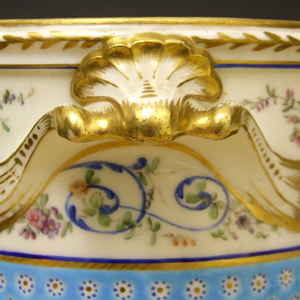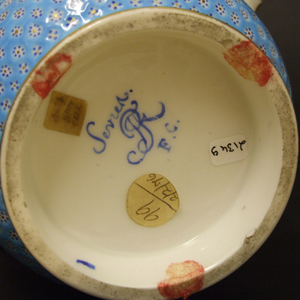
SEVRES c.1794 – 1795.
A Fine 18th Century Sevres Porcelain Seau a Bouteille (Bottle Cooler) from the First Republic Period July 1793 – 1804. The Upper Register Decorated with a Meandering Informal Thin Acanthus Scroll in Blue Enamel with Informal Garden Flowers, Fruit, Birds and a Classical Style Urn. The Lower Section Painted with a Pale Blue Pointille Ground. The Handles with a Gilded Shell to the Middle. The Base with a Large Mark in Blue Enamel : a Script `Sevres` Below an Intertwined Script `RF` for Republic Francaise, Below that the Painters Mark `F C` Who is an Unidentified Painter of Flowers who Worked at Sevres in c. 1793-1794.
SOLD
- Condition
- Perfect.
- Size
- Height : 13,2 cm (5 1/4 inches)
- Provenance
- An Old Auction Label, Probably Christie`s, with the Date l2/2/76
- Stock number
- 21349
Information
As a result of the spike in public violence and the political instability of the constitutional monarchy, a party of six members of France’s Legislative Assembly was assigned the task of overseeing elections. The resulting Convention was founded with the dual purpose of abolishing the monarchy and drafting a new constitution. The Convention’s first act was to establish the French First Republic and officially strip the king of all political powers. The King, by then a private citizen bearing his family name of Capet, was subsequently put on trial for crimes of high treason starting in December of 1792. On 16 January 1793 he was found guilty, and on 21 January, he was guillotined. Throughout the winter of 1792 and spring of 1793, Paris was plagued by food riots and mass hunger. The new Convention did little to remedy the problem until late spring of 1793, occupied instead with matters of war. Finally, on 6 April 1793, the Convention created the Committee of Public Safety, headed by Maximilien Robespierre, and was given a monumental task: “To deal with the radical movements of the Enragés, food shortages and riots, the revolt in the Vendée and in Brittany, recent defeats of its armies, and the desertion of its commanding general.” Most notably, the Committee of Public Safety instated a policy of terror, and the guillotine began to fall on enemies of the republic at an ever-increasing rate, beginning the period known today as the Reign of Terror. Despite growing discontent with the National Convention as a ruling body, in June the Convention drafted the Constitution of 1793, which was ratified by popular vote in early August. However, the Committee of Public Safety was seen as an “emergency” government, and the rights guaranteed by the 1789 Declaration of the Rights of Man and Citizen and the new constitution were suspended under its control. The Committee carried out thousands of executions against supposed enemies of the young Republic, to the point that the guillotine came to be known as “the national razor”—because it seemed to be falling on everybody’s neck. The Committee’s laws and policies took the revolution to unprecedented heights—they introduced the revolutionary calendar in 1793, closed churches in and around Paris as a part of a movement of dechristianization, tried and executed Marie Antoinette, and instituted the Law of Suspects, among others. Under Robespierre’s leadership, members of various revolutionary factions and groups were executed including the Hébertists and the Dantonists, many of whom had been Robespierre’s personal friends. The war efforts were improving for France by 1794, due in part to the military excellence of Napoleon Bonaparte. Many in the National Convention were calling for a return to normalization, but Robespierre disagreed. Between the mass executions, the wild fear of the populous, and the institution of the Festival of Reason, by the middle of 1794 there was “a great deal of enthusiasm for ending the terror, [but] no one could figure out how to do it…The only thing that would end the terror, and apparently the only thing they could all agree upon, was the fall of Robespierre”. He was tried and executed on 24 July 1794.
The Directory After the fall of Robespierre, the Jacobin club was closed and the surviving Girondins were reinstated. In August, the National Convention adopted the Constitution of 1795. They re-established freedom of worship, began releasing large numbers of prisoners, and most importantly, initiated elections for a new legislative body. On 3 November 1795, the Directory was established. Under this system, France was led by a bicameral government, consisting of an upper chamber called the Council of Elders (with 250 members) and a lower chamber called the Council of 500 (with 500 members). The executive body consisted of five members who made up the Directory (from which the historical period gets its name). Due to internal instability and French military disasters in 1798 and 1799, the Directory only lasted for four years.


